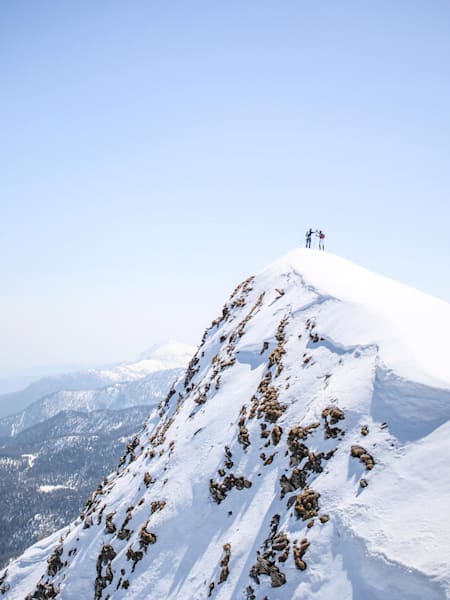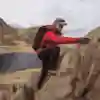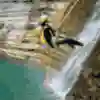Reaching a mountain summit is a mind-blowing experience, but what does it take to make it to the top? Mountaineering covers everything from extreme backpacking on long but non-technical trails through summit scrambling and ridge walking to hard-nut multi-pitch climbing up impossibly icy rock faces.
Trips can last multiple months or be as short as a day, but whatever your distance you need decent physical fitness, some technical know-how and, perhaps most importantly, the right mentality for the challenge. If you’ve got that, then read these tips and go get started.
1. Build up the basics
First off, get fit. Include walking and stair climbing in your daily routine, add regular running and cycling to build base fitness and do weights to strengthen the upper body. Also, go to a climbing gym to get a grasp of the basics, like being able to use a harness, belaying and tying into a rope.

1 min
These guys take climbing to new heights in Alaska
Watch these guys climb a peak no one has climbed before in Alaska.
Then put on a heavy rucksack and go up a hill. Do multi-day backpacking trips, practise scrambling and build confidence on large crags and ridges, both alone and roped with a partner. Finally, get comfortable doing all that in winter conditions – because mountaineering can be very cold.
2. Pick your target
Target the terrain and the exact difficulty of the climb you want
© Philipp Reiter/Red Bull Content Pool
Consider what terrain you want to take on – technical routes, granite faces, glaciated mountains, ice or mixed climbing or just walk-ups. Then plan long-term goals as well as setting out your starting plans.
Climbs are graded by height – in 1,000m brackets from 4Kers to 8Kers – and a class system based on steepness and exposure, with 1 flat and risk-free, 2 and 3 increasing in gradient and obstacles, 4 involving all-fours scrambling and 5 being highly technical with rock-climbing skills. Alpine grades are similar, from F (Facile) through PD, AD, D, TD to ED (Extrêmement Difficile).
Also, don’t be over ambitious. It’s better to feel good about your achievements than be disappointed you’re not hitting your targets.
3. Take a course
A guide can teach you best practice and impart crucial mountain knowledge
© Christian Gamsjäger/Red Bull Content Pool
The ‘mountain bible’ Freedom of the Hills is a good place to start and if you have mountaineering friends they can teach you the basics, but nothing beats taking a course. Going out with a guide puts you in the mountains and gives you on-the-spot feedback and that crucial personal experience.
Courses are usually six days on class 2-3 routes and cover route planning, navigation, safe travel, rock climbing and logistics like weather analysis and mountain rescue. Some also cover snow and ice, including techniques for self-arrest and glacier hiking. Having all these in your locker helps you become more independent in your decisions on the mountain.
4. Become master of the maps
Knowing how to read a map is crucial to high mountain survival
© Philipp Reiter/Red Bull Content Pool
As the the best mountaineers say, the more navigation experience you have the better. Practise at home by plotting a course between two points on any map. Plan real routes you can go out and do and find POIs you can navigate to. Use all the tools – GPS, compass, altimeter, map contours, triangulation, bearings and sightings. And once you’re confident, get lost and try to navigate back.
Predicting your pace is crucial for planning as it helps avoid overdoing days and exhausting yourself. Make sure you estimate well. Measure a distance on a path near your house and pace it out – but pace hill walks too so you know how it changes when it gets steeper, higher and you get more tired.
5. Get the gear
The equipment has to be right for the type of mountaineering you do
© Greg Mionske/Red Bull Content Pool
Layer your clothes, use merino-wool socks and boots with a hard outer and removable soft inner to help you stay dry. Use a light backpack, just big enough to fit the basics. For climbing, get a harness, helmet, the right length rope and a decent set of gear. And if you’re going on ice use 12-point semi-rigid crampons and a 60-90cm gently curved piolet axe.
Take a headlamp, because mountaineering starts early and if you end up getting lost you don’t want to be lost in the dark. Don’t skimp on a cheap tent or you’ll regret it if you’re hit by 120kph winds, snow and ice. Be prepared for an emergency with bivvy gear and a small first-aid kit.
Get to know how a paralysed ex-rugby player climbed the equivalent height of Mount Everest:
6. Prepare for altitude
Any 3Ker or above and you’re likely to be affected by altitude. Don’t take it lightly. At its mildest, it can cause insomnia, lost appetite and nausea, all of which destroys your motivation and fitness. At its worst, it can lead to pulmonary edema, which floods your lungs and can be fatal.
Acclimatisation is vital. Go up slowly, climb high and camp low and the body can often work things out. Rehydrate and eat, even if you don’t feel like it. And out on the trail, use pressure breathing to regulate oxygen in the blood, slow your pace and take measured rhythmic steps. If you get disoriented or develop a cough, descend as quickly as possible.
7. Plan, plan, plan
Leaving nothing to chance, be prepared for all eventualities
© Christian Gamsjäger/Red Bull Content Pool
Start local or in a well-travelled region with easy access to information and well-defined routes. Plan days with pace in mind and don’t be too ambitious – a pitch or steep climb that looks easy on paper is tougher at the end of a tiring day with a big pack, especially at altitude. Allow weather contingency and always have Plan B in your pocket – quite literally.
Permits and logistics (and visas if going abroad) all need precision planning and language barriers can make things a lot harder.
When you hit the trail, go before sunrise and head down by early afternoon, especially in icy regions where sun melt increases the chance of rock falls through the day. Be flexible and adapt. If you end up having to make an unplanned bivvy high on the mountain, you’ve overdone it.
8. Build your skill set slowly
It's hard work, but you'll enjoy the ride when you complete a major ascent
© Philipp Reiter/Red Bull Content Pool
Build up gradually and learn as you go. Never try something out for the first time on a big trip. Practise skills in a safe environment and be confident in them before you need them. You don’t need to be in the mountains – you can set up a crevasse rescue at home or an ice-axe arrest on a muddy bank.
It takes many trips to get a sense of reading conditions and it also takes time to learn to work with your partner and move together smoothly and efficiently but safely, knowing when to switch between pitched climbing and short-roped hiking.
Finally, if you feel yourself hitting a buffer, don’t be too proud to hire a guide to help take you to the next level. It’s safer to expand your skill set with an expert than to gamble on your own.













